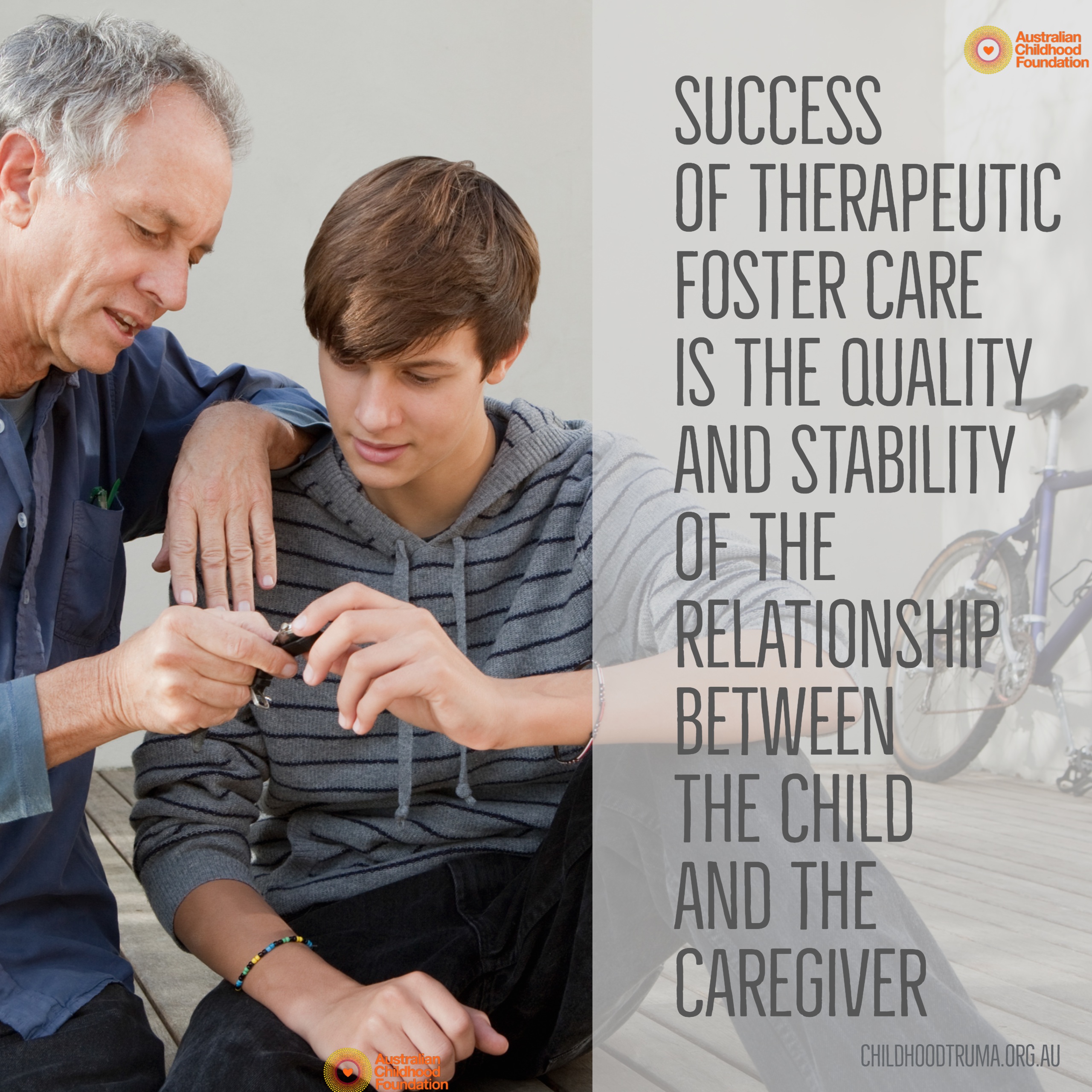
It Takes a Village – Shared Care – A place in out of home care

I know I have been a part of something amazing when I get goose bumps reflecting on the journey. I want to share with you the experience of a 16yo male we worked with a in our Therapeutic Care program in regional Victoria
Central to the success of therapeutic foster care is the
equality and stability of the relationship between the child and the caregiver. We will present a model in which multiple caregivers can promote options for the young person and increased sustainability of placement. The importance of the partnership in applying a therapeutic framework has been a critical ingredient to success. This young person’s journey supports a shared care model as a valuable option to be considered in the delivery of care, and one that may provide increased stability for adolescents in foster care.
 Where did this young person come from?
Where did this young person come from?
Similar to many young people who enter out of home care ‘Heath’ had been injured by a cumulative pattern of significant abuse during critical phases of his early childhood. He entered out of home care aged 11 and had been diagnosed with an intellectual disability.
Heath’s presentation in out of home care included aggressive behaviour hoarding dirt, constantly moving objects around the home, complained of hearing voices in his head and banging his head against a wall/door/floor to stop the voices. Heath had thoughts to kill himself, his anxiety appeared to be increasing and he was physically aggressive towards his sibling.
Heath was sectioned under the mental health act and placed in a High Dependency Unit for containment and further assessment.
Heath was hurting
Heath was good at writing letters. Here is an extract from one:
“I want to kill myself. I am sick of people telling me what I can and can’t do. It makes me feel like I’m stupid when people tell me off. I look stupid. I want to go and commit suicide. I want to put a bullet in my head”.
Heath was discharged from mental health to a residential unit. There were no home-based care placements in the division. At the time the only placement likely to provide stability was a residential placement far from his community and family.
It was going to take hard work. We had a plan…
- Locate carers who were able to provide care for Heath until he turned 18. We advocated strongly that he could be cared for in a home-based care placement with therapeutic support.
- The carers needed to have an understanding of trauma and Heaths specific needs.
- The carers needed to be willing to establish and maintain effective working relationships in a care team environment.
- To locate a placement in Heath’s community to retain relationships with family, school and sporting clubs.
The out of home care provider couldn’t find one carer. However, they found two sets of carers that together were willing to share the care of Heath. The crisis of a placement breakdown compelled consideration of pathways previously not explored in therapeutic care. The framework of this care model deviated from the traditional model of care and involved a shared care approach.
What did it look like?
- Heath resided in each primary carers home on a fortnightly basis.
- Respite care occurred once a month.
- Fortnightly care team meetings occurred; in line with Heath’s changeover to carers.
- Heath received mentoring twice a week, strengthening his connection to community and opportunity to stablish positive relationships.
- Heath was enrolled in full time education.
- Heath was supported to maintain his sporting commitments.
- Heath was involved in decision making; his voice was heard, valued and responded to.
Who were these carers?
- They lived in different towns however close enough to travel and maintain Heath’s education at school and his sporting commitments.
- There were two primary caregivers in each home and no other children in their primary full time care.
- They were provided relevant information to develop an understanding of Heath’s history and underlying needs.
- They shared a goal to provide a reparative caring environment for Heath whilst supporting him in developing the skills he would require to successfully transition to exit care in 18 months.
Key elements to success
The case managers’ relationship was pivotal. It was one of the enduring relationships for Heath which he valued and was important in connecting Heath to others.
The case managers’ key role was to:
- Maintain the one key relationship Heath had and support and advocate for him in connecting to others
- Responsible for care team coordination and communication
ACF therapeutic specialist had a key role to:
- Maintain a strong relationship with the case manager to provide a coordinated and consistent approach to Heath’s care based on his therapeutic needs.
- Support collaborative decision making in Heath’s best interests
- Ensure Heath’s model of care is seen through the therapeutic lens.
It was important to
- Maintain the relationship between the Case Manager and the young person given the change in care types typically a young person would experience a change in case manager;
- Establish and maintain a schedule of fortnightly care team meetings;
- Ensure that clear lines of communication between all key stakeholders;
- Provide therapeutic support as needed to the care team;
- Develop a consistent structure, routine and boundaries between all caregiving placements.
What was the end result?
- Heaths needs were met.
- He developed a positive safe relationship with two sets of carers.
- He maintained a strong sense of belonging to community.
- He maintained and strengthened his connection to family.
- He was provided with reparative care.
- Shared care allowed the carers to recharge their batteries and stay focused, purposeful, energetic.
- All carers had strong links to community and focused on supporting Heath to thrive. Heath was able to access opportunities that would not have been available within a traditional care model.
Considerations for shared care
- Matching primary carers in line with their own family dynamics.
- Matching primary carers skills set to the child/young persons needs.
- Key stakeholders to be open minded and flexible in decision making.
- Set clear goals.
- Listen to the child/young person.
- Clear lines of communication.
- Therapeutic support.
Our assessment indicated that the shared cared approach provided a positive balance for the caregivers. Their capacity to commit to a shared goal and provide reparative responses to this young person mitigated consequences that could have arisen from having multiple caregivers. We found that the shared care approach had far reaching benefits for all involved that have led to us to advocate for this model to be considered when working with young people in similar circumstances into the future.
It takes a village
 One of Heath’s caregivers identified a process for the carers and Heath to support the transition of exiting care. The carer invited carers and professionals that had been involved in his out of home care journey to join in knitting a blanket for Heath. People were given instructions to knit a square, or even hold the wool whilst someone else knits a square for them, and then have their photo taken to show they have been part of the process. The photos were then compiled into a book. At Heath’s 18th birthday he was presented with the handmade knitted blanket in his favourite football colours. Heath also received his book of photos representing all the people that hold him in mind and have been a part of his journey. Needless to say, the carers relationship with Heath will extend beyond his placement with them.
One of Heath’s caregivers identified a process for the carers and Heath to support the transition of exiting care. The carer invited carers and professionals that had been involved in his out of home care journey to join in knitting a blanket for Heath. People were given instructions to knit a square, or even hold the wool whilst someone else knits a square for them, and then have their photo taken to show they have been part of the process. The photos were then compiled into a book. At Heath’s 18th birthday he was presented with the handmade knitted blanket in his favourite football colours. Heath also received his book of photos representing all the people that hold him in mind and have been a part of his journey. Needless to say, the carers relationship with Heath will extend beyond his placement with them.
I feel confident for Heath’s future. It took a team of remarkable people who were prepared to be brave, learn for each other, work hard together, be flexible, innovative and remain focused on Heath’s best interests.
Final words from Heath
Heath has advice for carers considering shared care, “The main thing is communication between each other and let them know how ‘little Johnny’ is going”.
Heath also has some words of wisdom for young people, “Just take it one step at a time, and see if you like it, and if you don’t, you can always tell them”.
All identifying information has been changed to protect the young person’s identity.
